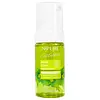What's inside
What's inside
 Key Ingredients
Key Ingredients

 Benefits
Benefits

 Concerns
Concerns

 Ingredients Side-by-side
Ingredients Side-by-side

Water
Skin ConditioningPotassium Cocoyl Glycinate
Disodium Cocoyl Glutamate
CleansingButylene Glycol
HumectantCocamidopropyl Betaine
CleansingNiacinamide
SmoothingCentella Asiatica Extract
CleansingDipotassium Glycyrrhizate
HumectantGlycyrrhiza Glabra Root Extract
BleachingSalicylic Acid
MaskingAscorbyl Glucoside
AntioxidantDMDM Hydantoin
PreservativeHydroxyethyl Urea
HumectantCamellia Sinensis Leaf Extract
AntimicrobialGlutathione
Sodium Ascorbyl Phosphate
AntioxidantSebacic Acid
BufferingAllantoin
Skin ConditioningCitrus Junos Seed Extract
AntioxidantCitrus Unshiu Peel Extract
MaskingActinidia Chinensis Seed Extract
Skin ConditioningFragaria Chiloensis Fruit Extract
Skin ConditioningVitis Vinifera Leaf Extract
Skin ConditioningVitis Vinifera Skin Extract
AntioxidantGarcinia Mangostana Peel Extract
Skin ConditioningParfum
MaskingWater, Potassium Cocoyl Glycinate, Disodium Cocoyl Glutamate, Butylene Glycol, Cocamidopropyl Betaine, Niacinamide, Centella Asiatica Extract, Dipotassium Glycyrrhizate, Glycyrrhiza Glabra Root Extract, Salicylic Acid, Ascorbyl Glucoside, DMDM Hydantoin, Hydroxyethyl Urea, Camellia Sinensis Leaf Extract, Glutathione, Sodium Ascorbyl Phosphate, Sebacic Acid, Allantoin, Citrus Junos Seed Extract, Citrus Unshiu Peel Extract, Actinidia Chinensis Seed Extract, Fragaria Chiloensis Fruit Extract, Vitis Vinifera Leaf Extract, Vitis Vinifera Skin Extract, Garcinia Mangostana Peel Extract, Parfum
Water
Skin ConditioningMyristic Acid
CleansingGlycerin
HumectantPalmitic Acid
EmollientStearic Acid
CleansingSodium Laureth Sulfate
CleansingTriethanolamine
BufferingCocamide DEA
EmulsifyingSalicylic Acid
MaskingPEG-7 Glyceryl Cocoate
EmulsifyingPEG-400
Emulsion StabilisingSodium Hydroxide
BufferingSulfur
AntiseborrhoeicPhenoxyethanol
PreservativeHydroxypropyl Methylcellulose
Emulsion StabilisingParfum
MaskingTriethylene Glycol
MaskingDisodium EDTA
Xylitylglucoside
HumectantAnhydroxylitol
HumectantXylitol
HumectantSodium Chloride
MaskingCellulose Gum
Emulsion StabilisingGlucose
HumectantWater, Myristic Acid, Glycerin, Palmitic Acid, Stearic Acid, Sodium Laureth Sulfate, Triethanolamine, Cocamide DEA, Salicylic Acid, PEG-7 Glyceryl Cocoate, PEG-400, Sodium Hydroxide, Sulfur, Phenoxyethanol, Hydroxypropyl Methylcellulose, Parfum, Triethylene Glycol, Disodium EDTA, Xylitylglucoside, Anhydroxylitol, Xylitol, Sodium Chloride, Cellulose Gum, Glucose
Ingredients Explained
These ingredients are found in both products.
Ingredients higher up in an ingredient list are typically present in a larger amount.
Parfum is a catch-all term for an ingredient or more that is used to give a scent to products.
Also called "fragrance", this ingredient can be a blend of hundreds of chemicals or plant oils. This means every product with "fragrance" or "parfum" in the ingredients list is a different mixture.
For instance, Habanolide is a proprietary trade name for a specific aroma chemical. When used as a fragrance ingredient in cosmetics, most aroma chemicals fall under the broad labeling category of “FRAGRANCE” or “PARFUM” according to EU and US regulations.
The term 'parfum' or 'fragrance' is not regulated in many countries. In many cases, it is up to the brand to define this term.
For instance, many brands choose to label themselves as "fragrance-free" because they are not using synthetic fragrances. However, their products may still contain ingredients such as essential oils that are considered a fragrance by INCI standards.
One example is Calendula flower extract. Calendula is an essential oil that still imparts a scent or 'fragrance'.
Depending on the blend, the ingredients in the mixture can cause allergies and sensitivities on the skin. Some ingredients that are known EU allergens include linalool and citronellol.
Parfum can also be used to mask or cover an unpleasant scent.
The bottom line is: not all fragrances/parfum/ingredients are created equally. If you are worried about fragrances, we recommend taking a closer look at an ingredient. And of course, we always recommend speaking with a professional.
Learn more about ParfumSalicylic Acid (also known as beta hydroxy acid or BHA) is a well-known ingredient for treating skin that struggles with acne and clogged pores. It exfoliates both the skin's surface and deep within the pores to help clear out buildup, control oil, and reduce inflammation.
Unlike AHAs (alpha hydroxy acids), salicylic acid is oil-soluble. This allows it to penetrate into pores which makes it especially effective for treating blackheads and preventing future breakouts.
Salicylic acid is also known for its soothing properties. It has a similar structure to aspirin and can calm inflamed or irritated skin, making it a good option for acne-prone skin that is also sensitive.
Concentrations of 0.5-2% are recognized by the U.S. FDA as an over-the-counter topical acne product.
It can cause irritation and/or dryness if one's skin already has a compromised moisture barrier, so it's best to focus on repairing that before introducing this ingredient into your routine.
While salicylic acid does not increase sun sensitivity, it’s still important to wear sunscreen daily to protect your skin.
If you are looking for the ingredient called BHA or Butylated Hydroxyanisole, click here.
Learn more about Salicylic AcidWater. It's the most common cosmetic ingredient of all. You'll usually see it at the top of ingredient lists, meaning that it makes up the largest part of the product.
So why is it so popular? Water most often acts as a solvent - this means that it helps dissolve other ingredients into the formulation.
You'll also recognize water as that liquid we all need to stay alive. If you see this, drink a glass of water. Stay hydrated!
Learn more about Water